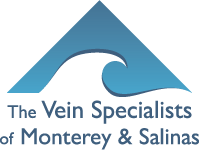Spider vein treatment
Spider veins are those little red or purple veins that you see close to the skin surface on your legs that are under 1 millimeter in diameter (in other words, really small). They drain into bigger veins deeper under the skin.
Cosmetic sclerotherapy is performed to close the visible abnormal spider veins. A sclerotherapy session lasts 15-30 minutes. To get good results, at least three sessions are needed. The main limitation is how much medicine we can give you in one day.
Before deciding on sclerotherapy treatment, your physician will need to do a history, physical examination and possibly an ultrasound. The purpose of this evaluation is to make sure that sclerotherapy is the best treatment for your specific situation. Some patients have an underlying vein flow problem which can only be seen on ultrasound, and which must be fixed before sclerotherapy can be effective. Other patients have a contraindication to treatment, in other words, some other medical issues that make it too risky to perform sclerotherapy.
Most people would describe a sclerotherapy session as irritating but not painful. Each person handles discomfort differently, however, so some patients would say sclerotherapy does not hurt at all and some patients would say sclerotherapy is painful.
After sclerotherapy, you need to wear your prescription compression stockings beginning immediately after treatment, for the next 7 days and including the first night. Wearing compression stockings improves the results of sclerotherapy. This is because sclerotherapy closes the vein, but keeping pressure on that closed vein keeps the body from trying to open it back up again. The body’s response to the closed vein is either to try to open it back up again, or to absorb it like the body heals a bruise.
Almost all patients see an improvement after sclerotherapy, but not all the veins we treated will likely clear after only one session. To get the best results, you will need at least three sessions. It usually takes around 6 weeks to see the results of your sclerotherapy session, so sessions are typically scheduled around 6-8 weeks apart.
Sclerotherapy, like any vein treatment, is not a cure for chronic vein disease, and you may get more abnormal veins. Occasionally a vein which closed may reopen, but abnormal veins which happen months or years later are usually just a progression of chronic vein disease.
The risk of a serious complication (something potentially dangerous) with sclerotherapy is low. Millions of sclerotherapy sessions are performed around the world every year, however, so multiple possible complications have been reported.
Alternatives to sclerotherapy include surface laser and phlebectomy. Surface laser is generally considered the backup treatment to sclerotherapy for leg spider veins because it is usually less effective and more painful than sclerotherapy. However, it is the best treatment if the spider veins are too small to get a needle into. Phlebectomy, the surgical removal of abnormal veins under local anesthesia, is generally reserved for large varicose veins because it is more painful than sclerotherapy.
